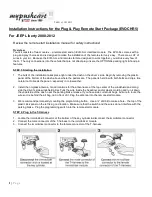
The Tire and Loading Information label also lists the
tire size of the original equipment tires (C) and the
recommended cold tire inflation pressures (D). For
more information on tires and inflation, see
Tires on
page 5-13
and
Inflation - Tire Pressure on
page 5-19
.
There is also important loading information on the
Certification/Tire label. It tells you the Gross
Vehicle Weight Rating (GVWR) and the Gross
Axle Weight Rating (GAWR) for the front and rear
axles. See “Certification/Tire Label” later in this
section.
Steps for Determining Correct Load Limit
1.
Locate the statement “The combined weight
of occupants and cargo should never exceed
XXX kg or XXX lbs” on your vehicle’s
placard.
2.
Determine the combined weight of the driver
and passengers that will be riding in your
vehicle.
3.
Subtract the combined weight of the driver
and passengers from XXX kg or XXX lbs.
4.
The resulting figure equals the available
amount of cargo and luggage load capacity.
For example, if the “XXX” amount equals
1400 lbs and there will be five 150 lb
passengers in your vehicle, the amount of
available cargo and luggage load capacity is
650 lbs (1400
−
750 (5 x 150) = 650 lbs).
5.
Determine the combined weight of luggage
and cargo being loaded on the vehicle. That
weight may not safely exceed the available
cargo and luggage load capacity calculated in
Step 4.
6.
If your vehicle will be towing a trailer, the load
from your trailer will be transferred to your
vehicle. Consult this manual to determine how
this reduces the available cargo and luggage
load capacity for your vehicle.
The vehicle is not designed or intended to tow a
trailer.
4-18
Summary of Contents for Equinox Fuel Cell
Page 18: ...Put someone on it Get it up to speed Then stop the vehicle The rider does not stop 1 14...
Page 76: ...NOTES 1 72...
Page 103: ...NOTES 3 3...
Page 104: ...Instrument Panel Overview 3 4...
Page 180: ...NOTES 4 24...
Page 235: ...Maintenance Schedule 6 2 Maintenance Replacement Parts 6 2 Section 6 Maintenance Schedule 6 1...
















































